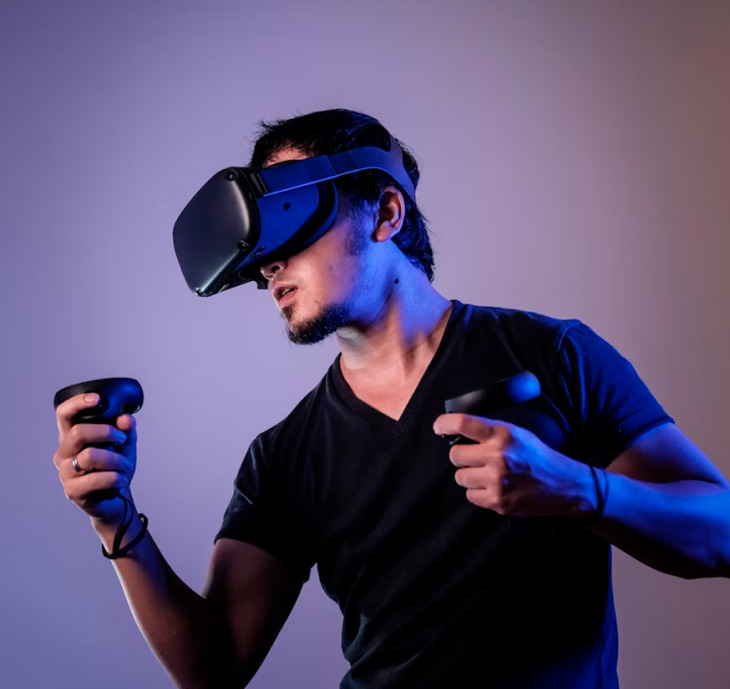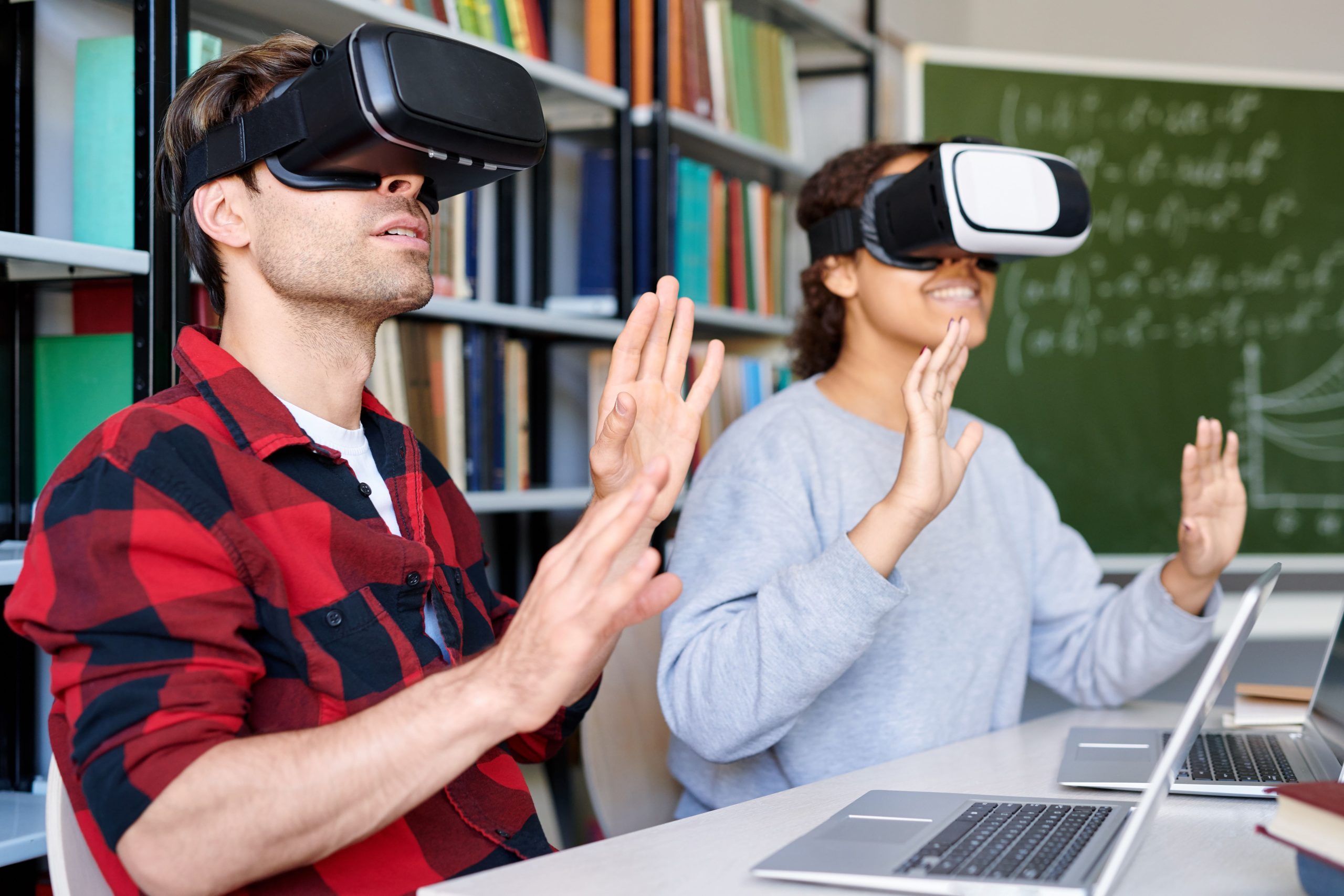Immersive learning is a cutting-edge educational approach that takes learning beyond traditional classroom settings. It’s a method that captivates learners by fully immersing them in realistic, interactive environments. This approach leverages advanced technologies to create simulated scenarios, enabling students to actively participate and gain a deeper understanding of the subject matter. In this article, we will delve into the concept of immersive learning, explore its key characteristics, and discuss its significance in modern education.
At its core, immersive learning is about active engagement. Unlike passive forms of learning, where students are mere spectators, immersive learning encourages them to become active participants in the educational process. Learners are placed in scenarios that mimic real-life situations, allowing them to make decisions, solve problems, and experience the consequences of their actions
One of the defining characteristics of immersive learning is the use of realistic simulations. These simulations replicate real-world scenarios, offering learners the opportunity to learn from their mistakes without real-world consequences. Whether it’s a flight simulator for pilots, a medical simulation for healthcare professionals, or a historical reenactment for history students, these simulations provide hands-on experience and foster practical skills.
Immersive learning also embraces multisensory engagement. It incorporates various sensory stimuli, including visuals, sounds, and sometimes even tactile feedback, to create a holistic learning experience. This multisensory approach enhances understanding and retention of the subject matter, as learners are more deeply immersed in the content.
Immediate feedback is another critical aspect of immersive learning. Learners receive instant feedback on their actions and decisions within the immersive environment. This feedback loop allows for continuous learning, helping students recognize errors and adjust their strategies in real-time. It promotes self-directed learning and empowers learners to take control of their educational journey.
Immersive learning represents a transformative shift in education. Its active engagement, realistic simulations, multisensory experiences, and immediate feedback contribute to a more profound and memorable understanding of the material. As immersive technologies continue to advance, their applications in education are expanding across various disciplines. Whether it’s virtual reality, augmented reality, mixed reality, or simulations, immersive learning is paving the way for more effective and engaging educational experiences. It holds immense potential to reshape how we learn, making education more interactive, impactful, and tailored to individual needs.
Characteristics of Immersive Learning
Immersive learning, characterized by its dynamic and engaging nature, boasts several key features that set it apart from traditional educational methods. These characteristics combine to create a highly effective and memorable learning experience:
Active Participation: At the heart of immersive learning is active participation. Instead of passively absorbing information, learners are actively involved in the learning process. They become decision-makers and problem solvers, taking charge of their own educational journey. This high level of engagement not only enhances comprehension but also encourages critical thinking and practical application of knowledge.
Realistic Simulations: Immersive learning relies heavily on realistic simulations. These simulations replicate real-world scenarios, providing learners with a safe environment to experiment, make mistakes, and learn from them. Whether it’s practicing medical procedures, experiencing emergency situations, or navigating historical events, learners gain practical skills and valuable experience.
Multisensory engagement: Immersive learning employs multiple sensory channels to deliver content. Visuals, sounds, and sometimes even tactile feedback are integrated to create a multisensory experience. This approach enhances understanding and retention, as learners are fully immersed in the subject matter. Multisensory engagement is particularly effective for kinesthetic and visual learners.
Immediate feedback: Learners receive immediate feedback within immersive environments. This real-time feedback loop is invaluable for learning and improvement. It allows learners to recognize errors, adjust their strategies, and track their progress. Immediate feedback promotes self-assessment and encourages a growth mindset.
Adaptability: Immersive learning is highly adaptable to individual needs and preferences. Learners can progress at their own pace, revisiting challenging concepts as needed. This adaptability accommodates diverse learning styles and ensures that each student receives a personalized educational experience.
Engagement and motivation: Immersive learning naturally fosters high levels of engagement and motivation. The interactive and dynamic nature of this approach captures learners’ attention and keeps them actively involved throughout the learning process. This sustained engagement results in better knowledge retention and a deeper understanding of the material.
Practical application: Perhaps one of the most significant characteristics of immersive learning is its focus on practical application. Learners not only gain theoretical knowledge but also acquire practical skills that can be directly applied in real-world scenarios. This emphasis on real-world relevance prepares students for success in their chosen fields.
The characteristics of immersive learning combine to create an educational experience that is engaging, practical, and highly effective. Active participation, realistic simulations, multisensory engagement, immediate feedback, adaptability, and motivation make immersive learning a powerful tool for fostering deeper understanding and skill development. As technology continues to advance, the potential for immersive learning to revolutionize education across various domains is both exciting and promising.
Types of immersive technology
In the realm of immersive learning, various types of immersive technology are leveraged to create engaging and realistic educational experiences. Each type offers unique capabilities and applications, expanding the possibilities for immersive learning:
Virtual Reality (VR): Virtual reality is a leading immersive technology that places users in entirely computer-generated environments. VR headsets, like the Oculus Rift and HTC Vive, provide users with a 360-degree view of the virtual world, immersing them in a digital landscape. VR is particularly effective for technical training, medical simulations, and historical reenactments, allowing learners to interact with objects and scenarios as if they were physically present.
Augmented Reality (AR): Augmented reality blends digital information with the real-world environment. AR apps on smartphones or AR glasses, such as Google Glass, enhance learning by providing contextual information in real-time. AR is valuable for field-based training, location-specific educational content, and overlaying educational materials onto physical objects.
Mixed Reality (MR): Mixed reality combines elements of both virtual and augmented reality. It enables interactions with both physical and digital objects, seamlessly blending the two. Microsoft’s HoloLens is a notable example of MR technology. MR finds applications in scenarios where physical and virtual objects need to coexist, such as architectural design, engineering, and interactive storytelling.
Simulations: While not always categorized as immersive technology, simulations are fundamental to immersive learning. Simulations recreate real-world situations within controlled environments. Flight simulators for pilots, medical simulators for healthcare professionals, and business simulations for management training are just a few examples. Simulations provide hands-on experience and offer learners the opportunity to practice and refine their skills.
360-Degree Video: 360-degree video technology captures panoramic views of real-world or virtual environments. Learners can explore these videos by panning or tilting their devices, creating an immersive viewing experience. 360-degree videos are used in fields like geography, tourism, and documentary filmmaking to provide learners with immersive journeys to diverse locations.
Spatial Computing: Spatial computing is an emerging immersive technology that integrates physical spaces with digital content. It relies on sensors and cameras to map physical environments and overlay digital information seamlessly. Spatial computing is still in its early stages but holds promise for applications in education, especially for collaborative learning and design-oriented disciplines.
Each type of immersive technology offers distinct advantages for educational purposes, and the choice depends on the learning objectives and context. As technology continues to advance, the immersive learning landscape will continue to evolve, opening up new possibilities for engaging, interactive, and effective educational experiences. These immersive technologies are reshaping the future of education by providing learners with innovative and impactful ways to explore and understand the world around them.
Benefits of immersive learning
Immersive learning, with its dynamic and engaging characteristics, offers a host of compelling benefits that significantly enhance the educational experience. As we explore the advantages of immersive learning, it becomes clear why this approach is becoming increasingly prevalent in modern education:
Enhanced engagement: One of the standout benefits of immersive learning is its ability to captivate learners. Active participation, multisensory engagement, and realistic simulations combine to create an educational experience that keeps students fully engaged throughout their learning journey. This sustained engagement is particularly valuable in combatting learner disinterest and promoting active involvement.
Improved retention: Immersive learning excels at facilitating better retention of knowledge. The multisensory nature of the approach ensures that learners are fully immersed in the subject matter. This depth of engagement helps information become more memorable, leading to improved long-term retention and recall of content.
Practical application: Unlike traditional learning methods that often focus solely on theory, immersive learning emphasizes practical application. Learners not only gain theoretical knowledge but also develop practical skills that can be directly applied in real-world scenarios. This real-world relevance enhances their readiness for their chosen fields or professions.
Error-friendly environment: Immersive learning environments provide learners with the opportunity to make mistakes and learn from them without real-world consequences. This error-friendly atmosphere encourages experimentation and exploration, allowing learners to refine their skills through trial and error, ultimately fostering a deeper understanding of complex concepts.
Personalized learning: Immersive learning is adaptable to individual learning styles and paces. Learners can progress at their own speed, revisit challenging sections, and receive immediate feedback. This adaptability ensures that each student receives a personalized educational experience tailored to their specific needs.
Higher motivation: The dynamic and interactive nature of immersive learning naturally leads to higher levels of motivation among learners. When students are actively involved and see the practical value of their learning, they are more motivated to excel and achieve their educational goals.
Preparation for Real-World challenges: Immersive learning scenarios often mirror real-world challenges and situations. This prepares learners to face similar scenarios in their careers with confidence and competence. Whether it’s a surgeon practicing complex procedures or a pilot navigating tricky flight situations, immersive learning equips individuals to tackle real challenges effectively.
Cultivation of critical thinking: Immersive learning promotes critical thinking and problem-solving skills. Learners are presented with complex scenarios that require them to analyze situations, make decisions, and strategize. This cultivation of critical thinking is invaluable in preparing individuals to navigate the complexities of the modern world.
Immersive learning’s benefits, including enhanced engagement, improved retention, practical application, error-friendliness, personalized learning, higher motivation, real-world preparation, and critical thinking development, demonstrate its effectiveness as an educational approach. As technology continues to advance and immersive technologies become more accessible, the potential for immersive learning to reshape education and empower learners is brighter than ever. This approach holds promise for fostering a deeper understanding of subjects and preparing individuals for success in their chosen fields.
Applications in Education and Training
The applications of immersive learning in education and training are diverse and far-reaching. This educational approach, characterized by active engagement and realistic simulations, has found numerous uses across various domains. Here, we explore some of the key applications:
Technical and vocational training: Immersive learning is especially effective for technical and vocational training. It allows learners to practice hands-on skills in a safe, controlled environment. For example, automotive mechanics can use virtual reality to simulate complex repairs, and welders can refine their techniques without physical materials.
Medical and healthcare education: Immersive learning plays a critical role in medical and healthcare education. Medical students can practice surgeries and diagnoses through realistic simulations, improving their surgical skills and clinical decision-making. This technology is also used to train healthcare professionals for emergency situations.
Language learning: Language acquisition benefits from immersive learning by placing learners in immersive language environments. Virtual reality language lessons enable students to engage in conversations with native speakers, enhancing language fluency and cultural understanding.
STEM Education: Science, technology, engineering, and mathematics (STEM) subjects benefit from immersive learning experiences. Students can explore complex scientific concepts through interactive simulations and experiments, fostering a deeper understanding of STEM principles.
Historical and cultural education: Immersive learning allows students to travel back in time to historical events or visit far-off places virtually. This is valuable for history classes and cultural studies, providing learners with a more profound appreciation for different cultures and historical eras.
Soft skills development: Immersive learning is not limited to technical skills; it is also used for developing soft skills. Leadership training, team building, and communication skills can all be honed through immersive scenarios that mimic real-world interpersonal interactions.
Corporate training: Many organizations use immersive learning to train employees. This includes onboarding, compliance training, and skill development programs. Employees can engage in realistic scenarios related to their job roles, improving job performance and safety.
Simulated environments: Immersive learning can create simulated environments for various purposes, from architectural design and urban planning to flight training and disaster preparedness. These environments allow learners to explore, analyze, and make decisions within these contexts.
Challenges and Future of Immersive Learning
While immersive learning offers tremendous benefits, it also faces challenges and holds exciting possibilities for the future:
Cost and accessibility: High-quality immersive technology can be expensive to acquire and maintain, limiting access for some educational institutions and individuals. Ensuring affordability and accessibility is a challenge for widespread adoption.
Content development: Creating immersive content requires specialized skills and resources. Developing high-quality simulations and scenarios can be time-consuming and costly.
Technical limitations: Immersive technologies continue to evolve, but technical limitations such as hardware requirements, motion sickness in virtual reality, and limited battery life in augmented reality devices can hinder the user experience.
Assessment and evaluation: Traditional methods of assessing learning may not align with the active, experiential nature of immersive learning. Developing effective assessment strategies is an ongoing challenge.
Data privacy and security: Collecting data from immersive learning experiences raises privacy and security concerns. Protecting user data and ensuring compliance with regulations is crucial.
Inclusion and Equity: Ensuring that immersive learning is accessible to all learners, regardless of physical or cognitive abilities, is an ongoing challenge. Equity considerations need to be addressed.
The future of immersive learning holds promise. As technology advances, immersive experiences will become more affordable, accessible, and realistic. The integration of artificial intelligence and machine learning will enhance personalized learning experiences. Innovations in haptic feedback, gesture recognition, and eye tracking will further improve user interactions. The challenges are real, but the potential for immersive learning to revolutionize education and training is vast, offering a path toward more engaging, effective, and tailored learning experiences.






